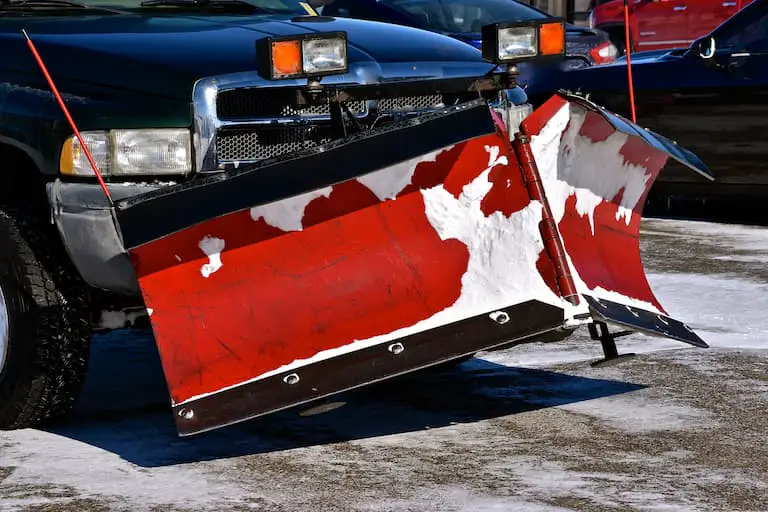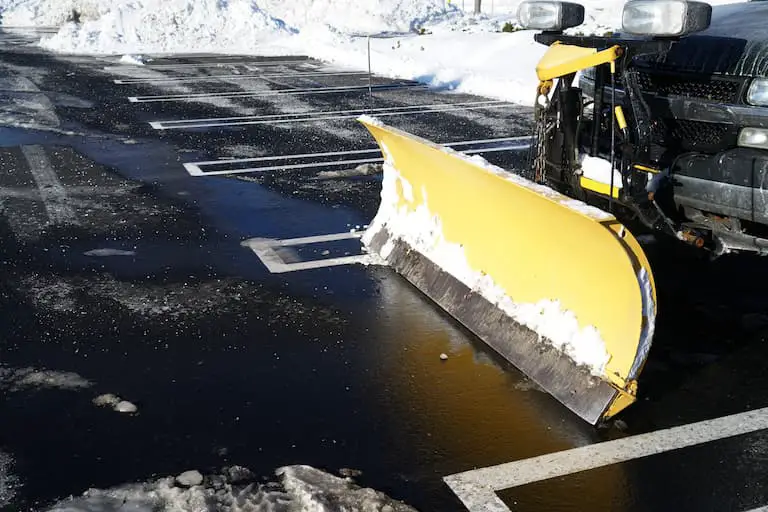As an Amazon Associate, we earn from qualifying purchases. We may also earn commissions if you purchase products from other retailers after clicking on a link from our site.
Plowing snow is not on most people’s list of fun things to do when it snows. But when you need to clear the road or driveway, you don’t need something like snow sticking to your plow and slowing you down. So how can you keep your plow snow-free?
Here’s how to keep snow from sticking to your plow:
- Don’t start with a warm plow.
- Use a silicone spray.
- Spray WD-40 on the plow.
- Vegetable cooking oils can create a slick surface.
- Spread petroleum jelly on your plow.
- Furniture, paste, or beeswax can keep snow off your plow.
- Use snowboarding or ski waxes.
- Let your snowplow cool down.
- Get rid of rust.
Where you live, the type of snowfall and the condition of your plow contribute to how well your plow will shed snow, so what works for someone else might not work for you. This article has 9 tips, and one of them is bound to work for you. Let’s get started.

1. Don’t Start With a Warm Plow
You know what happens when snow hits a warm surface, right? It melts, and it can create an icy surface. If you start with a warm plow, you could create conditions that would keep the snow on your plow as you work through the snowfall.
The best place to keep your plow is either in an unheated garage or on your truck outdoors. This keeps it at the ambient temperature and ready to use after a major snowstorm.
Why Snow Sticks to Metal
Because of steel’s thermal conductivity, when the snow first falls on your metal plow, the snow begins to melt. And when the temperature of the plow dips below freezing, the melted water turns to ice.
Since the ice is jagged, snow sticks to it, eventually weighing down the plow.
If the temperature of the plow could stay above freezing, the melting snow wouldn’t stick and turn to ice. Therefore, in theory, heating the plow would keep the plow ice-free. In practice, however, doing so would be impractical, expensive, and challenging.
Even if a plow could have heating elements added to it, it wouldn’t change the surrounding temperature. And that would create a new problem. It may appear like heating snow to melt it would be a simple solution, but it could create a new problem.
Unless the water evaporates, it will fall to the ground, where it is likely to freeze and turn to ice. And if water freezes on the road or driveway, the ice-covered driveway or road will be more dangerous.
This might explain why heated snowplows are not a thing.

2. Use a Silicone Spray
One solution is to create a slick surface that doesn’t let snow or ice stick. Unfortunately, the moisture content or temperature of the snow can affect how well a product works.
A silicone spray can be used to protect objects from moisture because it is water-resistant. It creates a film that causes water to bead up and roll off the surface instead of sticking, and it can help with rust prevention.
A product like B’laster Industrial Strength Silicone Lubricant (available on Amazon) has a higher silicone concentration than many other brands. Unlike some silicone lubricants, B’laster’s formulation includes a Teflon Fluoropolymer.
Spray the entire plow thoroughly, including the backside, top, and face. Depending on how much snow you receive and how often you plow, you might need to apply the spray several times.
However, it is not expensive as sprays go and are easy to apply.
3. Spray WD-40 On the Plow
Many people assume that WD-40 is a lubricant, but it is not. Instead, WD40 is a rust remover and degreaser. A one-time application can prevent ice from forming for one plow session, but you will need to reapply it every time you plow.
WD-40 has met the demand for a waterproofing spray that contains silicone. The WD-40 Specialist Water Resistant Silicone Lubricant Spray (available on Amazon) lubricates and waterproofs metal, it dries quickly, and doesn’t leave a sticky residue.

4. Vegetable Cooking Oils Can Create a Slick Surface
Many folks swear by vegetable cooking oil, either in spray or spread on. The oil is a lubricant and keeps the snow from sticking.
The advantage of using a product like Pam is its convenience. Simply spray so that you coat the entire plow, and you’re ready to move snow. But the disadvantage is that sprays or wipe-on coatings only last for one or at most two plows.
When you finish moving snow, wipe down the plow to keep it clean and avoid a build-up of dirt.
5. Spread Petroleum Jelly On Your Plow
Another suggestion is to rub petroleum jelly on the plow to keep the snow from sticking. Apply the petroleum jelly and coat the plow until it shines. This stuff usually stays in place often, but you’ll want to keep some handy should you need to reapply it.
6. Furniture, Paste, Or Beeswax Can Keep Snow Off Your Plow
Any type of wax you have on hand can help keep snow off your plow.
If you have stick candles, you can wipe the plow down with that, or if you have furniture wax, this should work as well. You can use inexpensive furniture wax, but the spray must be kept inside the house since it won’t work if frozen. However, it outlasts WD-40 and is also more environmentally friendly.
There are two other waxes that can work just as well.
Paste Wax
A paste wax, whether for furniture or cars, is another option. Both create a smooth finish so snow will slip off the plow before it has time to turn to ice. Car wax, like Formula 1 Carnauba Car Wax (available on Amazon), is more suited to outdoor use and will last longer.
Its water beading protection will last up to a year, and applying the wax is relatively easy. In addition, high-quality car wax will help fill in minor scratches, cutting down on ice sticking on your plow.
Beeswax or Candle Wax
Hard wax, such as beeswax or candle wax, is another excellent option that will keep the surface of the blade slick. So if you have some handy, give it a try. As it is a hard wax, applying it takes longer than other options.
7. Use Snowboarding and Ski Waxes
Waxes for snowboarding and skiing provide a smooth glide, so they should also work, if you have some handy, that is. However, stay away from cross-country waxes. Hard waxes and Klister waxes are used for different snow conditions.
8. Let Your Snowplow Cool Down
A warm snowplow leads to more ice and snow build-up, so either keep it outside or let it sit in the cold before you start plowing. If you’ve been using it for quite a while and it’s starting to hang onto the snow more, the friction might have warmed it up a bit. Take a break, let the plow cool down, then go get at it again.
9. Get Rid of Rust
Rust and pitting cause problems because the ice and snow will get snagged in the pits, which begins the build-up of snow. Less snow will stick to your plow if you can get rid of the rust. Once the weather warms up, consider sanding down the plow to remove the rust. Then paint with a clear coat, let it cure, and wax it.
Bottom Line
One or more of these tips should help you keep a plow snow-free. Unfortunately, no one product will work in every situation, otherwise, that product would exist. So instead, you will have to use trial and error to find what works for you.
